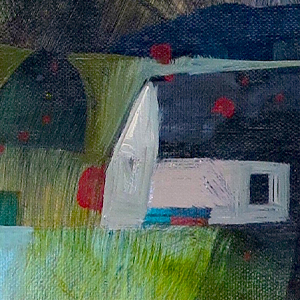
Employing Virtue
Creating a Culture of Virtuous Leisure in a World of Total Work
Paul Blaschko
Artwork: “Road into Summer” by Susan Abbott © 2024
The Ant and the Grasshopper, A Modern Retelling
A clean-cut college junior walks briskly across the quad, head down, clutching an overstuffed padfolio with drafts of his resumé and forty marked-up cover letters, one for each prestigious internship he’ll be applying for. As he looks down to grab one of the sheets of paper that are slipping out, he suddenly collides with a wandering freshman who, with empty hands in empty pockets, is reciting a passage of some poem about dragonflies. The loose leaves are thrown into the air, flipping and spinning, catching flashes of sunshine as they float to the ground. The freshman suddenly comes to attention in a moment of epiphany. “Oh,” he cries, “That’s what those are for!”
Neither student is the hero of this parable, at least not in my telling of it. Each represents values our students bring to our college campuses—values that we, as educators, reinforce or resist. These values produce tension in our shared life on campus that often shows up as contradictions in the lecture hall, during office hours, or in the varied communications with which we recruit and retain our students, and then communicate with them as alumni and eventual donors.
The contradictions also show up in our own intellectual lives as professors. We shake our heads about status-obsessed students, even as we obsess about publishing in top-tier journals ourselves. We can’t understand why students are more concerned with getting an ‘A’ than diving deep into the substance of the Republic. But when we go back to our offices we work tirelessly on all manner of professional trivia while our own copies of the Republic gather dust on the shelf.
I think we all know deep down that the ever-increasing pressures to produce, accomplish, and achieve are somehow incompatible with the environment we’re trying to create as educators; that the values driving us in our professional lives lead to a cognitive dissonance that’s easier to diagnose and dismiss when we see it show up in the personal and professional aspirations of our students. “Don’t worry about that internship, just focus on learning,” is about as comforting and useful to a college sophomore as the advice I once received from a much older colleague, “Don’t publish in graduate school or in your first couple years as a faculty member, you really don’t have anything substantive to contribute until you’ve been working for 3–5 years.”
The contemporary university campus has become as much a part of what Josef Pieper calls the “world of total work” as the factory was in the middle of the nineteenth century, and as bursting with frenetic activity as a Silicon Valley tech start-up is today.1 Whether it’s fundraising, program-building, publishing, or cranking out lectures, I’d venture to guess that very few of us in academe feel like we’re “living the life of the mind” or ever approaching what the ancients would have recognized as contemplation.
What we need, then, is an anchor—something to which we can hold fast as we populate our Google Calendars and book travel for the coming semester. Something that will tether us to our real work, that will help us align our efforts with our purpose. Something we can credibly propose to our students as a touchstone or locus for a well-integrated life. But what could possibly provide us with such stability?
The Problem:
We’ve Forgotten What We’re Doing
Say that our shared goal in higher-ed is to help students integrate work into well-lived lives while contributing to healthy communities. And say we also aim to instill a love of learning for its own sake. That is to say: suppose we are actually aiming to deliver a liberal education. The first claim I want to convince you of is that the way we spend our time and effort is, in general, radically misaligned with these goals.
Anyone who stops to think about it will see that students learn as much or more from the cultures of their universities as they do from explicit instruction or teaching. Consider the differences you observe at freshmen orientation versus commencement or, at my university, during Senior’s Week. Somehow our students transform in remarkably uniform ways. By the end of their four years on campus there are any number of archetypes that have been embodied, and any observant faculty member could probably differentiate between a roving band of finance majors and an anxious cluster of classics majors. More broadly, the vast majority of students walking across the stage to get their diplomas share so much more in common with any one of their peers at that moment than virtually any other demographic group to which they belong. They exude a similar energy. They possess similar aspirations. They speak a common dialect.
While recent pedagogical reforms have emphasized course-level learning goals and backward design, we’ve largely overlooked what is arguably the primary source of designable student learning: university culture. If we take our role as educators seriously, then, we need to focus as much on community and culture building as we do on determining what to include in our syllabi.
Neglecting this hidden curriculum comes at a high cost. It’s not just student disengagement that I’m worried about here, or the growing pressure to articulate the value of a liberal arts education in utilitarian terms. Those issues are downstream and, I think, require far more nuanced diagnoses and treatments than any I’ve yet encountered. I’m worried about the very integrity of academe, about well-placed public mistrust, and that our laser focus on the thin criteria used in rankings will prevent us from asking the important questions until it’s too late. The stakes, in my mind, could not be any higher.
So here’s my pitch: I think professors who genuinely care about the educational mission of their university should commit themselves to building “virtuous cultures of leisure,” and that administrators should do everything in their power to enable this work. In characterizing such cultures, I note striking overlap with practices that contribute to such cultures and practices associated with “leisure” in the classical sense. By more clearly articulating this connection, I aim to demonstrate how investment in the community of the university, in building up a culture of leisure and contemplative learning, promotes the learning goals we should all care about most deeply.
In short, my suggestion is that those of us in higher-ed whose primary commitment remains educating students for their own (and for the common) good should recapture “scholē” as the root or foundation of our schools, that is: to be a place where leisure and learning go hand in hand both inside and outside of the classroom. To do this, we need to seed and nurture cultures of virtue and contemplative leisure while taking seriously the “life of action” for which we are purportedly preparing most of our students.
Achievementism, Our Contemporary Work Ethic
The term “work ethic” was coined by sociologists in the 1950s to describe the cultural attitudes we’ve adopted toward work. These theorists built on a project started in the 1930s by Max Weber, who was trying to understand how capitalism came to be embedded in Western culture in the 20th century, and why it took the form of large, bureaucratic institutions hyper-focused on rational organization, efficiency and, productivity in continuous pursuit of the maximization of profit.
A work ethic can be understood as an implicit cultural understanding of the moral value work plays in a well-lived life. It exists at the level of the social unconscious, but it both governs behavior at the individual level and helps explain social phenomena. The American endorsement of the beliefs that hard work is inherently virtuous, for instance, or that those who don’t work are lazy helps explain both why we idolize and why we try to emulate figures like Steve Jobs and Elon Musk. It also helps explain why it’s historically been difficult to gain widespread support for social programs like Universal Basic Income.
Weber’s insight was that the work ethic of post-reformation Christianity laid the groundwork for capitalism to flourish. A belief that social classes reflected a divine order, for instance, or that the acquisition of wealth (so long as it wasn’t spent) reflected blessedness as a sign of salvation. In today’s world, we’ve largely abandoned the moral and religious worldview in which this work ethic was forged. But its effects continue to haunt us.
We are driven by an insatiable desire for personal and professional achievement. It is grounded in the belief that personal value is bound up with success in the sphere of work, that self-improvement has, as its aim, efficiency and productivity at work, and that achievement in work is the grounds of our self-worth. The philosopher Byung Chul Han aptly notes this ethos at work at a cultural level: “Today’s society” he claims, is “. . . a society of fitness studios, office towers, banks, airports, shopping malls, and genetic laboratories. Twenty-first-century society is . . . an achievement society.” Inhabitants of an achievement society are “achievement-subjects . . . [they are] . . . entrepreneurs of themselves.”2
I will call this work ethic “achievementism,” and define it as the philosophical position that our purpose and value lie in continuous achievement: that self-worth depends on and reflects one’s status and success is both the means to, and the end of, a well-lived life. In an apt analogy, Arthur Brooks likens our obsession with achievement to an addiction:
People sacrifice their links with others for their true love, success. They travel for business on anniversaries; they miss Little League games and recitals while working long hours. Some forgo marriage for their careers—earning the appellation of being “married to their work”—even though a good relationship is more satisfying than any job.3
Achievementism isn’t so much a well-articulated philosophy that we consciously endorse. It’s more like a theory posited to explain our actual behavior. There are our “beliefs” and then there are our beliefs. If actions speak louder than words, achievementism is the creed we’re living by when we miss our kids’ t-ball game to finish a report.
Weber described the effects of the protestant work ethic as creating an “iron cage,” a social framework that promises freedom, but delivers a Sisyphusian cycle of production and consumption fueled by ever-expanding desires. Achievementism does the same thing but in an even more pernicious way. As “entrepreneurs of ourselves” we’ve internalized a drive that prior generations enforced through control, discipline, and religious prohibition. As Han observes, “Prohibitions, commandments, and the law [have been] replaced by projects, initiatives, and motivation.” Today’s workaholic engages in “auto-aggression” and “auto-exploitation,” forms of motivation that are far more efficient than any sort of managerial domination. Our “iron cage” has been gilded, and we’ve come to embrace its glittering bars.
As achievement-subjects, Han claims, we have come to see inactivity as a “deficiency that must be overcome as quickly as possible.”4 Han’s thesis, though it’s been updated for the age of Tik-Tok in the style of continental philosophy and critical theory, is essentially a restatement of a thesis Josef Pieper articulated in 1948. “[T]he original meaning of the concept of leisure,” Pieper writes, “has practically been forgotten in today’s leisure-less culture of ‘total work.’”5 In Pieper’s “culture of ‘total work,’” everything, including leisure and education, is reshaped to serve productivity. As inhabitants of it, he’s suggesting that we are so obsessed with work and achievement that we can only think of leisure in contrast to it, as a negative space between projects or a temporary break to recharge our biological batteries.
“What Does Leisure Look Like Today?”
This is a question that, quite frankly, stumped me in a class I teach called “The Working Life: Work, Meaning, and Happiness.” I’d spent so much of the time designing the class to scaffold the ideas we’d need to even articulate the debates surrounding the vita activa and vita contemplativa that I hadn’t stopped to apply the concepts in simple terms to everyday life. As a seasoned teacher, I quickly turned the question around on the student who’d asked it as I collected some thoughts on the differences between technē (skill), praxis (action), and theōria (contemplation), and each of their relevant virtues.
Even if the student was satisfied with the eventual response (which they probably weren’t), I found the question gnawing at me over the next few weeks. All of the historical touchstones that provided me with examples of leisure—ancient symposia, 18th-century salons, or even monastic rules of life—simply didn’t translate to the context I found myself inhabiting with my students. This question stayed with me—and I realized I didn’t have a clear answer. So, with some students and colleagues at Notre Dame, I built one.
Through a series of decidedly fortunate events, I found myself creating a community around this ideal within the College of Arts & Letters at Notre Dame. The vision statement for the Sheedy Family Program in Economy, Enterprise, and Society states: “We are an intellectually rigorous community at Notre Dame that goes beyond fundamentals to find deeper meaning in the practice of business through the liberal arts.” For those in whom I sense a similar pedagogical and philosophical disposition, I articulate the vision more briefly: We’re trying to integrate the life action with the life of contemplation through dialogue.
In the SFP, we group students into cohorts of thirty. During their first year in the program they take “Business in Context,” a gateway class that asks big questions like “Where did the term ‘Economy’ come from? What does it refer to now?” They also go on retreat to learn how to closely read poems like “The Road Not Taken,” and interrogate why it’s so often misinterpreted. We form bonds through competitions, academic workshops, and lightly structured late-night dialogues around a campfire on the shores of Lake Michigan. The whole community comes back transformed and ready to take on the rest of the curriculum.
This curriculum consists of more than just courses. While students do take more courses together (my “Work, Meaning, and Happiness” class, for example, and a senior seminar called “Investing and the Good Life”), most of our “curriculum” is experiential. We gather for three-hour dialogues over dinner each month in a room that looks like we’re on the set for Harry Potter or Downton Abbey. We trek to Chicago, New York, or Silicon Valley to pose questions to professionals that are sometimes deeply practical and sometimes deeply personal. All of these have philosophical dialogue at their core: we train our students to actively listen and carefully distinguish, to pose strong questions to their peers, and to respond to these questions with confidence and candor. We prohibit technology at all of these events, but, honestly, by the third or fourth week in the community, we rarely find ourselves having to enforce the prohibition. We’ve intentionally designed our programming to fit into our students’ busy lives, and we’ve negotiated a deal with them: We won’t ask you to attend anything we don’t believe is essential to your educational journey through the program, but when we do we want complete buy-in and undivided attention.
I explain all this because it is my answer to the prescient question my student posed. I believe this is what leisure looks like at the University of Notre Dame, I believe this is how we integrate the ideals of action and contemplation into a single life.
This program challenges our students to get out of the “achievementist” mindset. One of the most common questions I’m asked about is what sort of incentive we offer. Do students get a minor for the classes they take? Do they get an “honors” designation on their transcript? The answer is: nothing. Or, at least, nothing you’d recognize in the framework of achievement. The same is true for the faculty leadership team. Yes, we’re paid to do this work, but it’s not an engine that will propel us into an elite academic position. We could honestly be more “productive” by cutting the time we spend planning programs in half. For both us and for our students, though, the reward is largely intrinsic to the work. The end is contained within the means. It’s leisure, scholē: “Productive activity pursued for its own sake.”
Postscript:
The Moral of The Story
Stories with clear messages have largely gone out of fashion today. The fable or morality tale seems too didactic for our modern tastes, maybe even a bit manipulative. But I’m not opposed to a story with a clear moral. Even if we don’t agree with it, it can give us an interpretive starting point.
The two students that appear in the introductory story (stand-ins for Aesop’s “ant” and “grasshopper” respectively) represent motivations and values that all of our students can and should possess to some degree. They also represent motivations that we, ourselves, struggle with as achievement-minded professors. Integrating these through programming in credible ways—creating “curricula” consisting of both classes and real-world experiences, and architecting time and space for a community to bond through dialogue over meals or on retreat—is a way of moving toward that ever-elusive goal for institutions committed to a liberal arts education: helping our students integrate action with contemplation in the context of lives well-lived.
Notes
- Josef Pieper, Leisure: The Basis of Culture (St. Augustine’s Press, 1998), p. 26.
- Byung-Chul Han, The Burnout Society (Stanford University Press, 2015), p. 8–11.
- Arthur C. Brooks, “‘Success Addicts’ Choose Being Special Over Being Happy,” The Atlantic (July 30, 2020).
- Byung-Chul Han, Vita Contemplativa: In Praise of Inactivity (Cambridge: Polity Press, 2024), p. 1.
- Pieper, Leisure: The Basis of Culture, p. 26.
 Paul Blaschko teaches philosophy at the University of Notre Dame, and is the founding Director of the Sheedy Family Program in Economy, Enterprise, and Society. His current courses and writing focus on how the humanities can help us find meaningful work. He is the co-author of The Good Life Method (Penguin Press, 2022), and his second book Worklife: A Philosophical Guide is under contract with Princeton University Press.
Paul Blaschko teaches philosophy at the University of Notre Dame, and is the founding Director of the Sheedy Family Program in Economy, Enterprise, and Society. His current courses and writing focus on how the humanities can help us find meaningful work. He is the co-author of The Good Life Method (Penguin Press, 2022), and his second book Worklife: A Philosophical Guide is under contract with Princeton University Press.
Fall 2025
Part I: Employing Virtue
Chris Higgins
Anna Bonta Moreland
Karen E. Bohlin
Zena Hitz
Interlude: Meaningful Employment
Michelle Weise
Part II: Employing Vocation
MORE

















